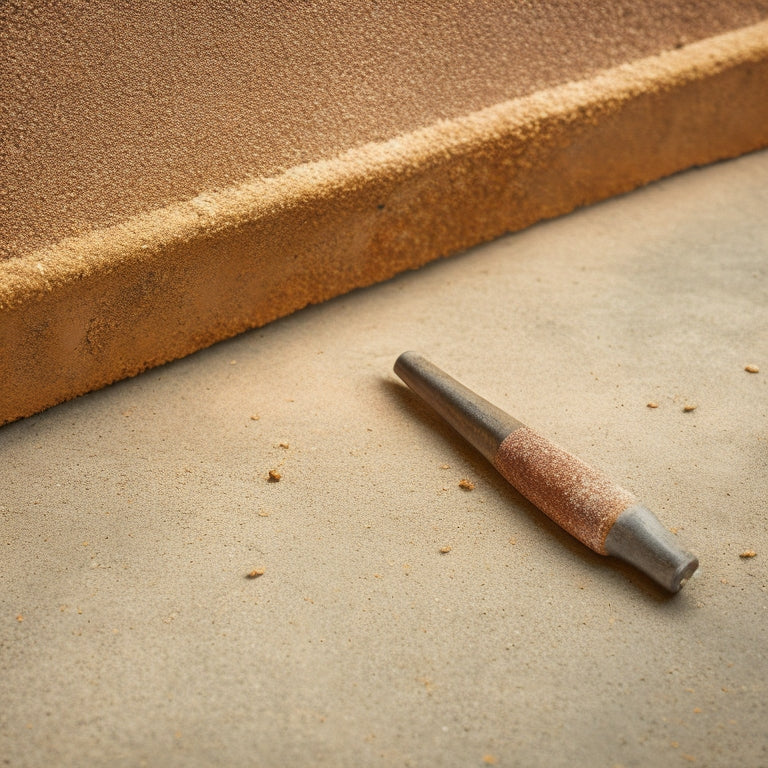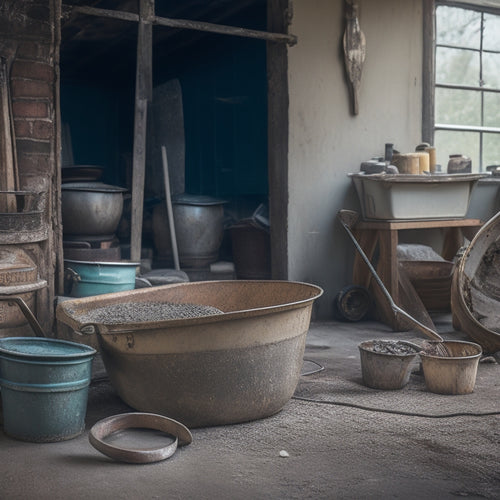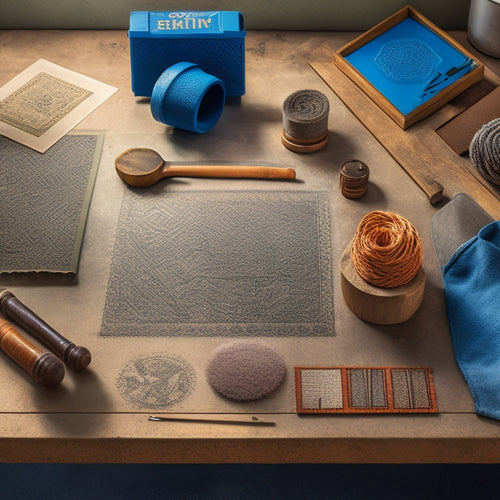
DIY Stucco Finishing Tools for Concrete Block Walls
Share
You'll need essential tools like a hawk, putty knife, darby, mixing bucket, and finishing tool to achieve a professional-looking stucco finish on your concrete block wall. Before applying stucco, prepare the surface by cleaning and evaluating moisture levels, addressing any damage, and applying a bonding agent if necessary. Mastering techniques like floating and scraping will help you achieve a smooth finish. With the right tools and techniques, you'll be well on your way to a durable and attractive stucco finish - and with a few more details, you can take your project to the next level.
Key Takeaways
- Essential tools for DIY stucco finishing on concrete block walls include a hawk, putty knife, darby, mixing bucket, and finishing tool.
- Prepare the concrete block surface by cleaning, assessing moisture, addressing damage, and applying a bonding agent if necessary.
- Apply the stucco base coat in consistent 1/4-inch thickness, avoiding air pockets, and working in sections for uniformity.
- Master floating and scraping techniques using wood or magnesium floats and a scraper to achieve a smooth finish.
- Finish with a smooth coat, applying thin layers, patching imperfections, and controlling application for a professional-looking result.
Essential Tools for Stucco Finishing
What makes a stucco finish truly exceptional is the quality of tools used to achieve it. You'll need a range of essential tools to guarantee a professional-looking finish. First, you'll require a hawk, a flat, handheld tool used to hold and apply stucco mixtures. A putty knife is also necessary for scraping and smoothing out the mixture. A darby, a long, flat tool, helps to flatten and smooth the stucco surface.
Proper tool maintenance is vital to achieve a high-quality finish. Regularly clean and store your tools to prevent rust and damage. Keep your hawk free of dried stucco by washing it with water and soap after each use. Store your putty knife and darby in a dry place, away from direct sunlight.
Additionally, you'll need a mixing bucket, a trowel, and a finishing tool, such as a float or a trowel, to achieve the desired texture and finish. Invest in high-quality tools, and maintain them properly to guarantee a long-lasting, exceptional stucco finish.
Preparing Concrete Block Surfaces
Before applying stucco, you must prepare the concrete block surface to verify a strong bond between the stucco and the substrate. This vital step guarantees a durable and long-lasting finish.
Start by cleaning the surface thoroughly to remove dirt, oil, or any other substances that might interfere with the stucco's adhesion. Use a wire brush or a pressure washer to remove debris and grime.
Next, assess the surface for any signs of moisture damage or efflorescence (salt deposits). If you notice any, address these issues before proceeding.
Perform a moisture assessment by applying a few drops of water to the surface. If the water absorbs quickly, the surface is ready for stucco application. However, if the water beads up or takes a long time to absorb, you may need to apply a bonding agent or a waterproofing treatment before applying stucco.
A well-prepared surface is fundamental for a successful stucco finish, so take the time to get it right.
Applying Stucco Base Coat
With the concrete block surface properly prepared, you're ready to apply the stucco base coat. This vital step sets the foundation for a durable and long-lasting stucco finish.
Begin by mixing the stucco according to the manufacturer's instructions, taking care to achieve a consistent blend. The ideal stucco mix should have a workable consistency, similar to thick paste.
Using a hawk or a flat trowel, scoop up a small amount of stucco mix and hold it at a 20- to 30-degree angle to the wall. With a smooth, continuous motion, apply the stucco to the wall, spreading it evenly to cover the entire surface.
Focus on maintaining a consistent thickness, typically around 1/4 inch. As you work, use a level to verify the stucco is applied straight and plumb.
Employ proper application techniques to avoid air pockets and unevenness. Hold the trowel at a slight angle to force the stucco into the block's crevices, filling all voids and gaps.
Work in small sections, completing each area before moving on to the next.
Floating and Scraping Techniques
Frequently, a well-executed float and scrape operation can make all the difference in achieving a smooth, even stucco finish.
You'll need to choose the right float type for your job. There are two common types: wood floats and magnesium floats. Wood floats are ideal for rough, textured surfaces, while magnesium floats are better suited for smoother surfaces.
When floating, hold the tool at a 45-degree angle and apply moderate pressure, using long, sweeping strokes to cover the entire surface. This helps to remove excess stucco and create a uniform base. Be careful not to apply too much pressure, which can create scratches or swirl marks.
Scrape techniques are also essential in achieving a smooth finish. Use a scraping tool to remove any high spots or imperfections. Hold the scraper at a 20-degree angle and use short, light strokes to remove excess material.
As you scrape, check your progress frequently to avoid over-scraping, which can lead to a rough surface. By perfecting these floating and scraping techniques, you'll be well on your way to a professional-looking stucco finish.
Finishing With a Smooth Coat
You're now ready to apply a smooth coat to your stucco finish.
Before doing so, make certain you've prepared the surface by filling any imperfections and cleaning the area to prevent defects.
Next, you'll apply the smooth finish using specialized tools and techniques to achieve a uniform, high-quality appearance.
Coat Preparation Essentials
Coat preparation is essential to achieving a smooth stucco finish, and it all begins with a thorough surface cleaning. Remove any dirt, oil, or debris from the concrete block wall using a wire brush or pressure washer. This guarantees a strong bond between the stucco and the wall.
Next, you'll need to address any cracks or imperfections on the surface. Fill them with a patching compound, and let it dry according to the manufacturer's instructions. Sand the area smooth to create an even surface.
Now, it's time to prime the surface. Apply a stucco bonding agent to the entire wall, following the manufacturer's mixing techniques and application instructions. This will help the stucco adhere to the wall, reducing the risk of cracks and delamination.
Allow the primer to dry completely before moving on to the next step.
With your surface primed and ready, you can begin applying the stucco. Make certain to mix the stucco according to the manufacturer's instructions, and apply it in thin, even layers.
Applying Smooth Finish
The finishing process begins with a smooth coat, which requires careful attention to detail to achieve a professional-looking result.
You'll need to apply a uniform layer of stucco mix, holding the trowel at a 20- to 30-degree angle to the wall. Use long, sweeping strokes to spread the mix evenly, working from the top of the wall down. This helps prevent drips and runs.
As you apply the smooth coat, focus on maintaining a consistent texture and avoiding any texture variation. To achieve this, keep the trowel loaded with the right amount of mix and use a smooth, controlled motion. Don't overload the trowel, as this can lead to an uneven application.
For a smooth application, use a darby or a finishing trowel to remove excess mix and flatten the surface.
Hold the darby at a 45-degree angle and use long, overlapping strokes to remove any ridges or bumps. Repeat this process until the surface is smooth and even.
Final Touches and Inspections
Most DIY stucco finishing projects require a few final tweaks before considering the job complete.
Now that you've applied the smooth finish, it's time to address any imperfections. Inspect the wall for areas where the texture variation might be inconsistent or where color matching could be improved. Use a putty knife to fill in any small gaps or voids, and then blend the filled areas with the surrounding stucco.
Next, inspect the wall for any minor defects, such as small cracks or pinholes. Use a patching compound to fill these imperfections, and then sand the area smooth.
If necessary, apply a second coat of finish to guarantee an even appearance. Finally, step back and evaluate the overall appearance of the wall. Check for any areas where the finish might be uneven or where additional texture is needed.
Make any necessary adjustments to achieve a uniform, professional-looking finish.
Frequently Asked Questions
Can I Use a Regular Trowel for Applying Stucco Base Coat?
You'll want to choose a trowel specifically designed for stucco application, as a regular trowel won't provide the necessary control or texture; opt for a stucco trowel or a notched trowel for a smooth, even base coat application.
How Do I Clean and Maintain My Stucco Finishing Tools?
You'll be a skilled stucco finisher if you keep your tools in top shape! Clean your trowels and floats daily with soap and water, and store them in a dry place to prevent rust; use a wire brush for tough grout, and a soft cloth for finishing tools.
Is It Necessary to Use a Bonding Agent on New Concrete Blocks?
When applying stucco to new concrete blocks, you'll typically need a bonding agent to guarantee a strong bond; choose from acrylic, epoxy, or polyurethane-based types, and make certain to properly prepare the concrete block surface for best adhesion.
Can I Apply Stucco in Direct Sunlight or High Winds?
When applying stucco, you'll want to avoid direct sunlight and high winds, as these weather conditions can cause uneven drying, cracking, and weakened adhesion; instead, choose a shaded or wind-protected area to guarantee ideal stucco application techniques and a strong, durable finish.
How Long Does It Take for Stucco to Fully Cure and Harden?
As you patiently wait for your stucco to change into a durable, rock-hard shield, remember that full curing takes around 28 days, depending on moisture retention, with stucco curing gradually, like a slow-cooked meal, absorbing and releasing moisture to achieve ultimate hardness.
Conclusion
You've successfully maneuvered the DIY stucco finishing process for your concrete block walls. Now, take a step back and admire your handiwork. Does your finished wall exude a sense of professionalism, or does it still need a bit of refinement? Remember, practice makes perfect, so don't be discouraged if it takes a few attempts to perfect the techniques. With the right tools and a bit of patience, you'll be a stucco finishing pro in no time.
Related Posts
-

Top Tools for Mixing Concrete at Home
When mixing concrete at home, you'll need a range of tools to guarantee a successful operation. Start with essential ...
-

5 Best Tools for Stamping Concrete Walls
When it comes to stamping concrete walls, you'll need a range of specialized tools to achieve the desired texture and...
-

Why These Concrete Tools Are Always in Demand
You rely on a set of trusted concrete tools to deliver high-quality results, and it's not surprising - these tools ar...


